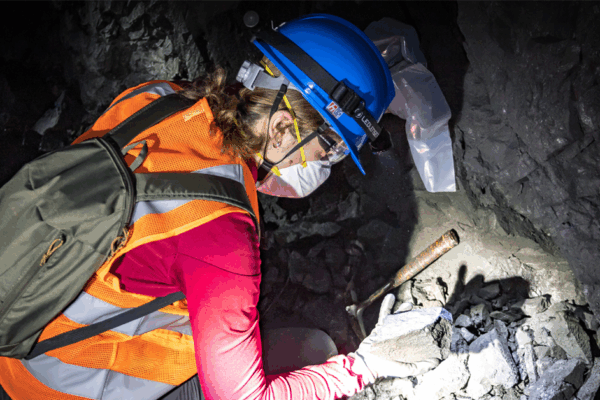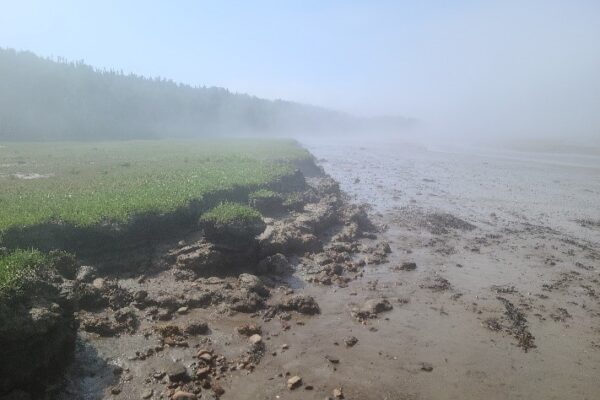- Overview
The series “Overview” highlights research in all its forms and takes an informed look at current events.

The Litli-Hrútur volcano. Photo: Anson Hancock
Four volcanic eruptions have been observed in Iceland since last December. In the Hawaiian Islands, Kīlauea, one of the most active volcanoes on the planet, erupted three times in 2023. Other, even more dangerous volcanoes are erupting now in places like Central America, Indonesia, and the Philippines.
Bringing risks of population displacement, health effects, and damage to infrastructure, these geological events can have major repercussions on a country and its inhabitants. But volcanoes have also shaped the world as we know it today and provided many benefits to humankind.
To better understand the significant role volcanoes play in both nature and human society, we talk to volcanologist Pierre-Simon Ross, a professor at INRS since 2007.

Professor Pierre-Simon Ross (left) and his students Sophie Leiter and Grégoire Pasdeloup at the summit of Cinder Cone, a relatively “new” scoria cone volcano in California. Lassen Peak is visible on the right.
Geologically, what purpose do volcanoes and eruptions serve? What are the benefits for the planet and for human beings?
The Earth’s crust and mantle locally consist of magma (molten rock). New magma is generated continually. Since magma tends to be less dense than the rocks that surround it, it rises toward the surface. When it reaches the surface, whether it be land or the bottom of the ocean, it creates—you guessed it—a volcano. An eruption allows a release of pressure.
Magma contains water and other gases that are emitted into the atmosphere during an explosive volcanic eruption, along with volcanic ash. Even eruptions that produce mainly lava flows, like the one currently happening in Iceland, release a great deal of gas. That’s why scientists believe volcanoes may have created the earth’s atmosphere and oceans.
Despite the natural hazards posed by eruptions, volcanoes have many benefits for humans. Many of Quebec’s metal mines, for example, extract their materials from ore deposits in volcanic or igneous rocks. The Abitibi and James Bay regions are mining hotspots, with volcanic rocks that are 2.7 billion years old. To put this in perspective, consider that the Earth itself is about 4.5 billion years old! These regions have active mines and major mining projects for gold, copper, nickel, lithium, and diamonds, related to the presence of ancient lava and magma. An ore deposit is a volume of rock that contains a significant quantity and sufficient concentration of a metal or mineral to allow for mining. The material is extracted by crushing the rock and concentrating the valuable metals or minerals. Depending on the substance, the metal content in a deposit is expressed in parts per million or weight percent.
Volcanic and igneous rocks are important for our economy as a source of metals and minerals—including the critical and strategic minerals needed for the energy transition. Due to the presence of deposits of gold, copper and zinc, I have active research projects in the Abitibi and James Bay regions, in partnership with the Geological Survey of Canada, the Ministère des Ressources naturelles et des Forêts du Québec, as well as mining and exploration companies.
Active volcanoes also make soil more fertile: just a small amount of volcanic ash provides beneficial nutrients such as magnesium and potassium. Soils with a healthy proportion of disintegrating ash are usually light (low density), dark-hued, and good at retaining water and organic matter. That makes them ideal for agriculture, allowing them to provide food for millions of people who live near volcanoes.
Volcanoes are also a source of building materials such as dimension stone and aggregates. Also, due to the presence of hot magma deep underground, it’s more efficient to produce geothermal energy near volcanoes. After a major explosive eruption, the atmosphere also cools for a year or two.
Finally, volcanoes generate geotourism, with millions of visitors attracted to sites every year. This is a major source of job creation in many parts of the world.

Iceland is often in the news for being home to the largest number of active volcanoes in Europe. But there are also eruptions reported in other parts of the world every week. Does Iceland have geological features that make it particularly interesting to volcanologists?
The geological events in Iceland since 2021 are of interest to volcanologists for several reasons. The Reykjanes Peninsula, southwest of the Reykjavík (Iceland’s capital), lies along the Mid-Atlantic Ridge, a mostly underwater mountain range formed by two tectonic plates. As these plates gradually move apart, they pull North America several centimetres further away from Europe every year.
The Reykjanes Peninsula was very active between the 8th and 13th centuries, but eruptions then paused for almost 800 years. Why did the dormant area suddenly reawaken in 2021? How long will the new eruptive phase near Grindavík last? These are some of the many questions that researchers want to understand.
A second reason why the current activity in Iceland is so interesting is the high success rate of the Icelandic Meteorological Office (IMO), the agency that monitors and predicts eruptions. The agency’s team uses advanced tools such as satellite technology to regularly check the accumulation of magma beneath the Reykjanes Peninsula.
On February 1, 2024, the IMO website announced that an eruption would occur within the next two weeks, and possibly in just a few days. The eruption ended up taking place on February 8, after 30 minutes of intense seismic activity: shallow earthquakes caused by magma rising to the surface. These earthquakes are an excellent way of predicting an imminent eruption and its specific surface location. There’s a distinction to be noted here: the recent eruptions in Iceland are characterized by long, linear fissures that allow magma to escape, rather than by the typical conical volcano structure that we tend to think of.
How does volcanology fit into interdisciplinary contexts? As a volcanologist, what kinds of collaborative projects are you involved in to advance scientific knowledge in the field?
Most volcanology experts (myself included) are trained geologists, but we also work with engineers, physicists, chemists, atmospheric scientists, geographers, and even archaeologists.
At the moment, I’m starting a team research project on volcanic ash from Mount Saint Helens in Washington state. We will be heading there this summer with volcanologists John Stix from McGill University and Alexa van Eaton from the Cascades Volcano Observatory to take samples near the volcano from the May 18, 1980, eruption. This ultra-violent eruption destroyed an area larger than the island of Montreal and sent ash high into the atmosphere which fell thousands of kilometres away. As far as Quebec? We’re not sure, but, working with biogeographer Julie Talbot from the Université de Montréal, and tephrochronologist Britta Jensen from the University of Alberta, we’re going to try to find ashes from this eruption in peat bogs in Quebec.
These peat bogs are actually important climatic and environmental archives: studying them allows us to reconstruct ancient climates over several thousand years, which is crucial for modelling future climates. Peat bogs are also major carbon sinks, which means they have a direct influence on the climate. To correlate the information we find in our peat bogs with those of the rest of North America, we need a detailed chronology of the peat layers. Volcanic ash that can be attributed to a specific eruption—such as that of Mount Saint Helens on May 18, 1980—serves as an excellent temporal marker. We also expect to find older ash from previous eruptions of this volcano, and even from Alaska, in the layers of peat. We hope that our work will result in a better understanding of the processes that lead to extremely violent volcanic eruptions like the one in 1980, and of how ash disperses over long distances.



